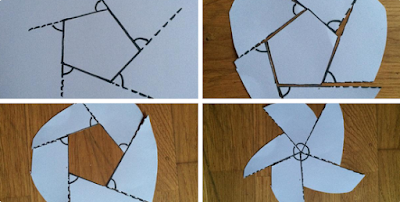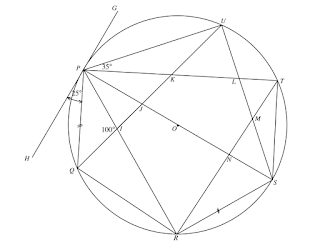- Attended #mathsconf4 in London and helped run the TweetUp
- Hosted #mathsTLP on Sunday night and #mathscpdchat (on behalf of the NCETM) on Tuesday night
- Had my first SLT lesson observation at my new school
- Did my first ever TeachMeet presentation at #TMEpsom
- Wrote three blog posts and processed a dozen new Pret Homeworks
- Travelled to Bath to attend and present at the MEI Conference.
Maths CPD
 I've already written about the importance of subject specific CPD. Although I do pick up some ideas from generic T&L events, my teaching benefits the most from conversations about maths - both the pedagogy and the subject. Unfortunately, aside from on Twitter, opportunities for such conversations are few and far between. My previous school's budget for external courses was zero (I'm not exaggerating! No external CPD allowed at all). So at the MEI Conference it was refreshing to see that some schools do still allow their teachers to attend conferences. I quickly discovered that the opportunity to learn about maths and develop as a teacher was immense.
I've already written about the importance of subject specific CPD. Although I do pick up some ideas from generic T&L events, my teaching benefits the most from conversations about maths - both the pedagogy and the subject. Unfortunately, aside from on Twitter, opportunities for such conversations are few and far between. My previous school's budget for external courses was zero (I'm not exaggerating! No external CPD allowed at all). So at the MEI Conference it was refreshing to see that some schools do still allow their teachers to attend conferences. I quickly discovered that the opportunity to learn about maths and develop as a teacher was immense.Because I was presenting on the Saturday I got to attend that day for free, and I was staggered by both how much I learnt and by how much I enjoyed learning. The choice of sessions was huge - over the three days there were 12 sessions and in each session delegates could choose from 8 options. Many, but not all, sessions were focussed on A level teaching and/or the use of technology.
Ideas for A Level
The first session I attended was "The aspirational grade E student" by David Philip and Claire Phillips. The session was about how to support AS maths students who have an E as their baseline/target grade. We started by discussing the reasons that so many students fail AS level maths and then found out what David and Claire have done at their school to improve results. I've thought about this issue before (see my post Bridging the Gap to A level) so it was great to hear what they've been doing, including:
Problem Solving
I also attended a session on Problem Solving at Key Stage 3 and 4 with Phil Chaffé. During this session I had fun trying out a range of maths problems.
My favourite problem, which I think would be particularly suitable for Year 8 or 9, was 'Zag Area 1', which is shown below and available to download (with solution) from Integral (login required).
The session notes also featured these business card problems from the FMSP - these will be available online from September.
All the problems featured in this session were drawn from Integral, the FMSP and Nrich. If you're looking for problem solving resources then do also check out my recent post Favourite Problems.
Mathematical Methods
 The slides for my session 'Tricks and Tips' are available here. This session was very similar to a workshop I presented at the National Mathematics Teacher Conference in March. It was about alternative mathematical approaches (eg all the different methods we can use to find the highest common factor of two numbers). If you look my 'Methods' page then you'll see the posts I wrote after the last conference explaining the content of my workshop.
The slides for my session 'Tricks and Tips' are available here. This session was very similar to a workshop I presented at the National Mathematics Teacher Conference in March. It was about alternative mathematical approaches (eg all the different methods we can use to find the highest common factor of two numbers). If you look my 'Methods' page then you'll see the posts I wrote after the last conference explaining the content of my workshop.
This time I added an extra section to my presentation - I spoke about how to factorise harder quadratics. I demonstrated three methods. The first was the 'guess and test' method (commonly used by anyone over the age of 20), the second was the 'grouping' method (used by many UK teachers) and the third was the 'slide and divide' method (sometimes used in the US, but considered a 'trick' by many). We talked about advantages, disadvantages and alternatives. If you're interested in finding out more then see my post Factorising Harder Quadratics, which I've just updated. An interesting alternative approach that many delegates had not seen before was 'the monic method', which is demonstrated in these two examples:
I hope that delegates found my session useful. I did get some nice encouraging feedback afterwards so I think it went well.
Summary
The plenary 'Bouncing Bombs and Boomerangs' by Dr Hugh Hunt, Senior Lecturer in the Department of Engineering at Cambridge University, was entertaining and fascinating. Overall my whole day at the MEI Conference was fantastic and I regret not being able to attend more sessions.- They run an algebra bootcamp in the three days before term starts for grade B GCSE students.
- They issue students with a self-assessment workbook containing the MEI exercise for each chapter (and links to solutions).
- They use a flipped learning approach for the basics (ie students watch videos at home in advance of some lessons). Feedback from students has been good.
- They have a department Twitter account (@mathsnewvic) which is the only way they communicate certain pieces of vital information (eg when the next test is).
- They give students information about what questions will be in assessments in advance (eg 'the next test will consist questions from 2011 past papers') - students then do all those questions to prepare for the assessment, which is better than doing nothing at all.
- They have whiteboard paint on the walls. I wrote about Vertical Whiteboards in Gems 7 and again I've been convinced of their effectiveness. There are lots of alternatives (eg magic whiteboards or writing on windows) if you can't use whiteboard paint. David and Claire said that often their students arrive in lessons and start solving problems on the walls straight away - sometimes they don't even put their bags down! If they get stuck they are much more likely to ask another student for help than if they were sitting down. Another delegate said that this approach had transformed her teaching.

Problem Solving
I also attended a session on Problem Solving at Key Stage 3 and 4 with Phil Chaffé. During this session I had fun trying out a range of maths problems.
My favourite problem, which I think would be particularly suitable for Year 8 or 9, was 'Zag Area 1', which is shown below and available to download (with solution) from Integral (login required).
The session notes also featured these business card problems from the FMSP - these will be available online from September.
All the problems featured in this session were drawn from Integral, the FMSP and Nrich. If you're looking for problem solving resources then do also check out my recent post Favourite Problems.
Mathematical Methods
 The slides for my session 'Tricks and Tips' are available here. This session was very similar to a workshop I presented at the National Mathematics Teacher Conference in March. It was about alternative mathematical approaches (eg all the different methods we can use to find the highest common factor of two numbers). If you look my 'Methods' page then you'll see the posts I wrote after the last conference explaining the content of my workshop.
The slides for my session 'Tricks and Tips' are available here. This session was very similar to a workshop I presented at the National Mathematics Teacher Conference in March. It was about alternative mathematical approaches (eg all the different methods we can use to find the highest common factor of two numbers). If you look my 'Methods' page then you'll see the posts I wrote after the last conference explaining the content of my workshop.This time I added an extra section to my presentation - I spoke about how to factorise harder quadratics. I demonstrated three methods. The first was the 'guess and test' method (commonly used by anyone over the age of 20), the second was the 'grouping' method (used by many UK teachers) and the third was the 'slide and divide' method (sometimes used in the US, but considered a 'trick' by many). We talked about advantages, disadvantages and alternatives. If you're interested in finding out more then see my post Factorising Harder Quadratics, which I've just updated. An interesting alternative approach that many delegates had not seen before was 'the monic method', which is demonstrated in these two examples:
I hope that delegates found my session useful. I did get some nice encouraging feedback afterwards so I think it went well.
Summary
So there ends my busy week. I've fallen way behind with my to-do list so now it's time to get back on track. First up, I'll continue to work on my page of resources for the new GCSE specification.
Thanks to MEI for organising such a high quality conference - I really hope I'm able to attend again next year.



















































